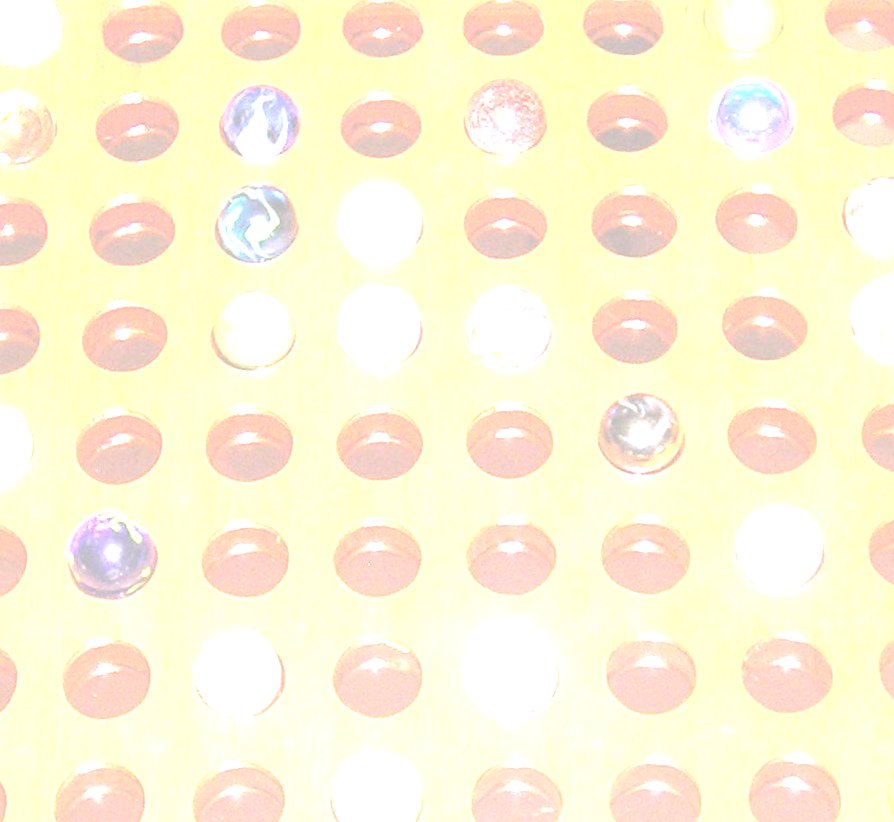Cipher
Sound Installation
Year of Completion: 2009
Cipher presents visitors with a board with an 8 x 8 grid of holes into which decorative
marbles provided can be placed.
Setting a marble in a hole initiates a sound idea that will continue for several minutes,
gradually decaying, unless the marble is first removed. Setting another marble into another
hole on the same vertical or horizontal axis as the first will, as well as triggering a new sound
idea associated with that hole, cause some form of sonic transformation upon the first sound
idea (if it is still active). The transformation could be a change in tempo or speed,
modulation of pitch, a spectral filter, rhythmic reconfiguration, or something else specific to
the nature of the original sound.
Considering the structure of holes in the interface, any sound idea begun can experience a
total of 14 (7 vertical and 7 horizontal) different transformations and in any combination.
Bearing in mind that there are 64 basic sound ideas, sonic outcomes based upon placement of
the marbles is enormous.
Visitors will, as well as enjoying the sonic experience of the piece, hopefully spend some
time trying to decode and understand at least some of the mechanisms of the piece.
The design of the piece suggests a puzzle or strategy game and in some ways the piece is
both a puzzle and a game but there is no solution (or perhaps it could be considered that
there are many solutions) and there is no winner. Strategy is advanced only through listening,
the visual and physical side of the piece serves only as an impression of the current musical
state of the piece.
[German/Deutsch]
Cipher bietet dem Besucher ein Brett mit einem Gitter von 8 x 8 Löchern, in die dekorative
Murmeln eingefügt werden können.
Wenn eine Murmel in ein Loch eingesetzt wird, initiiert diese eine Tonidee, die mehrere
Minuten anhält und allmählich vergeht, wenn die Murmel nicht früher entfernt wird. Wird
eine weitere Murmel in ein anderes Loch auf der gleichen horizontalen oder vertikalen Axe
wie die erste eingesetzt, löst diese nicht nur eine mit diesem Loch verbundene neue Tonidee
aus, sondern verursacht bei der ersten Tonidee eine sonische Transformation, so lange diese
noch aktiv ist. Diese Transformation kann eine Veränderung im Tempo oder in der
Geschwindigkeit, eine Modulation der Tonhöhe, die Anwendung eines spektralen Filters, eine
rhythmischen Rekonfiguration oder etwas anderes sein, das sich spezifisch auf den
ursprünglichen Toncharakter bezieht.
In Anlehnung an die Struktur der Löcher im Interface kann jede einmal begonnene Tonidee
insgesamt 14 verschiedene Transformationen (7 vertikale und 7 horizontale) in den
verschiedenen Kombinationsmöglichkeiten durchlaufen. Wenn man bedenkt, dass es 64
Grund-Tonideen gibt, ist das auf der Anordnung der Murmeln beruhende sonische Endergebnis
enorm.
Der Besucher kann nicht nur das sonische Erlebnis des Stückes genießen, sondern wird
hoffentlich etwas Zeit damit verbringen, wenigstens etwas von dem Mechanismus des Stückes
zu entziffern und zu verstehen.
Das Design der Schnittstelle erinnert an ein Puzzle oder ein Strategie-Spiel, und auf gewisse
Weise ist das Stück beides, Puzzle und Spiel, allerdings ohne Lösung (oder vielleicht mit
vielen Lösungen) und ohne Gewinner. Die Fortführung der Strategie geschieht lediglich durch
das Zuhören; das visuelle und physische Element des Stückes ist lediglich Eindruck des
gegenwärtigen musikalischen Stadiums des Stückes.
